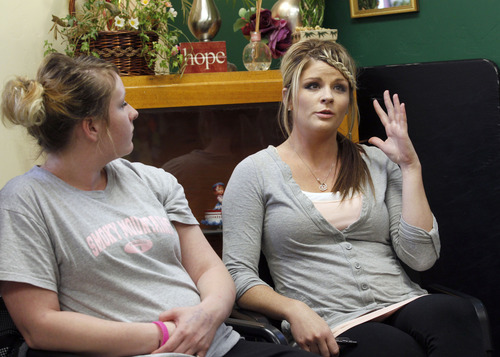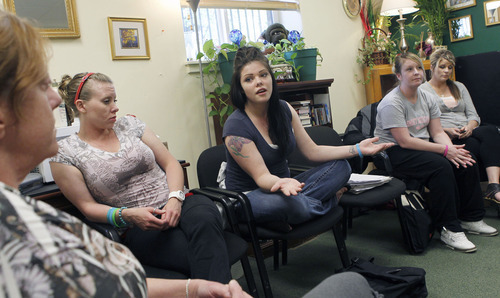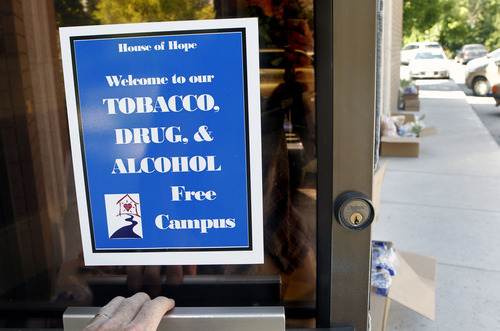This is an archived article that was published on sltrib.com in 2012, and information in the article may be outdated. It is provided only for personal research purposes and may not be reprinted.
One by one, the women in the circle recall how the addictions that led them on the path to this therapy group started with a drag on a cigarette.
Stealing a pack from their parents or bumming some from friends eventually led to using methamphetamine, heroin or cocaine as they chased a buzz.
To kick their illegal addictions, the women at Salt Lake City's House of Hope must also tackle their gateway drug: tobacco.
While smoke breaks were once built into therapy, the substance abuse treatment center has banned tobacco from its campuses.
"It's definitely a struggle not to smoke," said 21-year-old Jennifer Rhoades, a two-pack-a-day smoker who quit when she entered the residential program about a month and a half ago. She says she craves cigarettes more than heroin.
"If I go back to cigarettes, it could lead you back to what you don't want to use, for me an eating disorder and drugs," she said. "I don't want to have to rely on anything for my happiness."
This is the future of therapy in Utah.
The state departments of Health and Human Services have launched what they say is a major cultural change in every publicly funded facility that treats substance abuse or mental illness. Starting July 1 in many locations, smoking will no longer be allowed anywhere on campus, and clients who smoke will be offered help to quit.
—
'America's biggest drug problem' • Studies suggest quitting tobacco can help users avoid other addictions, since tobacco appears to affect the same neural pathway as alcohol, opioids, cocaine and marijuana.
And for people with mental illness, tobacco may be more of a killer than suicide. A 2006 study showed Utahns with mental illness die 29 years earlier than other adults — not just casualties of suicide but also of chronic respiratory disease, cancer and heart disease.
"[Nationally] if you take all the deaths attributable to alcohol and illicit drugs and car crashes and suicide [and homicide and HIV] … they still don't equal the number of people that are killed by tobacco-related problems," said Noreen Heid, in charge of the new initiative for the Division of Substance Abuse and Mental Health.
"It's America's biggest drug problem, and we've kind of not paid attention to it."
The new initiative, called Recovery Plus, is tied to a pending 2013 deadline for hundreds of agencies and businesses that contract with the state. They must expand the indoor smoking ban of 1995 — which affected all public places — to their outdoor campuses. Some are starting the switch or phasing it in now.
Supported by $189,000 in federal stimulus money for cessation therapy and other help, the switch will affect 61,500 individuals who get publicly-subsidized treatment.
While Utah boasts the lowest smoking rate in the nation, at 11 percent, a whopping 66 percent of Utahns entering substance abuse treatment smoke. Tobacco is their No. 1 drug of choice.
The state has never tracked smoking among mental health patients, which it will now start doing. National studies show half to 85 percent smoke.
Put another way, the program will reach 30,000 smokers — 15 percent of all Utah smokers.
—
'Not just recovery' • The initiative also shows greater expectations for people with behavioral disorders, said Rick Hendy, who oversees adult mental health programs for the Division of Substance Abuse and Mental Health.
"We really want to emphasize it's not just recovery from substance abuse or mental illness," he said, "but actually to be able to participate in life in a healthy way."
When the state banned smoking at Utah State Hospital in 2007, Hendy opposed it. Tobacco was used to make patients feel comfortable and engage in therapy. Nicotine was a carrot for good behavior: If patients calmed down, they'd be allowed to go outside to smoke.
Then he read how those with mental illnesses were dying at age 50. "Now that we know this data … we have an obligation to intervene," he said.
Some studies have suggested smoking lowers symptoms of some mental illnesses. But Utah officials note the so-called calming effects of nicotine that alleviate withdrawal symptoms are short-acting. Tobacco use changes how antipsychotic drugs are metabolized, leading patients to need more of them.
They add there were fewer incidents of aggressive behavior at Utah State Hospital after smoking was banned.
—
'Work in progress' • Some local governments that oversee the state's behavioral health agencies have already made the switch, including Davis Behavioral Health. Many will start July 1, with either complete bans or a phasing in, including Salt Lake, Weber, Tooele, Summit and Washington counties.
Jan Pendley, director of adult services for Davis Behavioral Health, timed the change to January's opening of a new smoke-free building.
She calls it a "work in progress." Most clients haven't quit and still need to be reminded not to smoke on the grounds.
"Some have reduced and some will need to try many times before they quit," she said.
Wasatch Mental Health is waiting until 2013 to ban smoking outdoors at its facilities in Utah and Wasatch counties.
Doran Williams, associate director, says he doesn't want to push mental health patients to the sidewalk to smoke because it could bother neighbors, such as those in an LDS Church building and Provo City offices. Plus, it stigmatizes patients.
"This Recovery Plus is a good idea," he said, but added: "It takes time. We're talking about people that have been smoking for years."
State officials acknowledge quitting may be harder for this population. It takes typical smokers eight to 10 tries to quit, said Janae Duncan, a specialist with the Utah Department of Health's Tobacco Prevention and Control Program.
And while half of adult smokers have tried to quit in the past year, just 6 percent succeed, according to the Centers for Disease Control and Prevention.
That's why the state won't deny treatment to patients who won't quit, and it will offer free nicotine replacement therapy. Medicaid covers various tobacco cessation medications. Uninsured, underinsured and insured patients can receive up to eight weeks of medication through the Utah quit line.
—
'They want to quit' • The House of Hope went smoke-free last September, after offering rewards, such as pizza parties and soda, to women who were quitting.
Program manager Melinda Melow-Murchie feared women would stay away from treatment. However, "My beds are just as filled as they have been," she said. "When you get down to it, they want to quit, they just [couldn't] do it."
At its residential facilities, the women must quit. Many of them move on to day treatment, where they can start again as long as they smoke elsewhere.
Though Ashleigh Johnson had wanted to stop sooner, the smoke-free policy spurred her on.
"When I hear people say, 'I can't wait to get to day treatment so I can light up a cigarette,' to me, it's like you might as well say, 'I can't wait to get out to shoot up.' "
Jacqueline Warr said she plans to remain a nonsmoker to stay out of jail. If she uses drugs, she said, she violates a court deal and will go to prison for 25 years to life for first-degree felony drugs and weapons charges.
If she smokes, she figures, she will head back to thinking, "I can hang out with these friends who are using and it's OK. Or, I can use this one time and that's OK. … To let my boundaries down is a life sentence."
Want help to kick tobacco?
Contact the Utah Quit Line at 1-800-QUIT- NOW or visit http://www.tobaccofreeutah.org.











